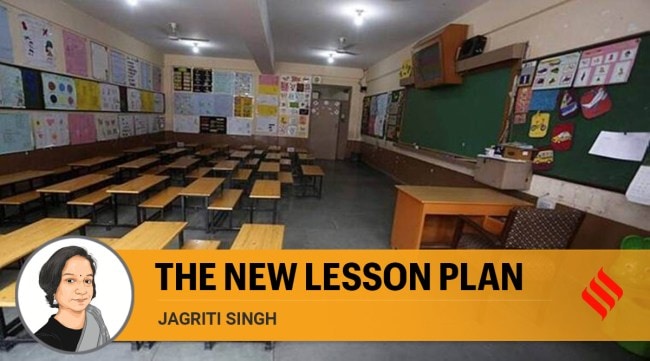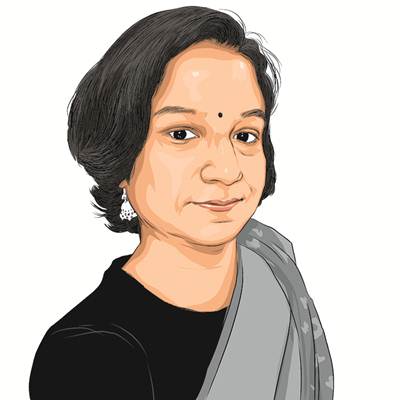Opinion Learning to teach in another disrupted year
🔴 2021 brought many challenges. But teachers, like everyone else in society, have coped in their own way
 Education has suffered a great deal during the pandemic. There were learning gaps that required immediate attention. (File)
Education has suffered a great deal during the pandemic. There were learning gaps that required immediate attention. (File) In March 2020, as I entered the staffroom, I first heard of a dangerous new infection spreading around the world. Within weeks, schools were closed, exams called off. Amid this, teachers stuck to business as usual, compiling results, planning for the next academic session. In about a week, I had started messaging my colleagues, concerned about the board exams ahead. I was scared as much about the pandemic as my students’ future.
Students and schools are what we know best. And there was a restless urge to return to that old normal. Rightfully, there was a focus on health and well-being for all of us, but that “teacher tingle” in us wanted to find a solution to the academic loss that was bound to affect students in the long run. I was in constant communication with my students through WhatsApp groups. We spoke about everything, their personal dilemmas, and their worries about the board exams, about losing crucial learning time and delayed results. None of these was an invalid concern for a teenager mid-way to taking their first board examination. There were other anxieties —students had lost loved ones, there was a lack of financial support at home; they were in crowded, small homes with distressed relatives. All of these were unusual situations and they were in distress—I had to pick up the phone and speak to them. I realised that we teachers needed to connect with our students at the earliest.
 Reading up about how teachers across the world were adapting to this disruption, I discovered Zoom, then Google Meet, then MS Teams, and a lot more. I started with short video calls with students, talking about random things or whatever they wanted to talk about. Once a platform was set, the students asked me to start classes for the next academic year. Many of my colleagues too started video classes. I always knew that teaching is a process of extended learning. What I found amazing was that going online came organically to most of us. Even the senior teachers, who had maintained a comfortable distance from technology or computers, came out of their comfort zones and learnt the required skills.
Reading up about how teachers across the world were adapting to this disruption, I discovered Zoom, then Google Meet, then MS Teams, and a lot more. I started with short video calls with students, talking about random things or whatever they wanted to talk about. Once a platform was set, the students asked me to start classes for the next academic year. Many of my colleagues too started video classes. I always knew that teaching is a process of extended learning. What I found amazing was that going online came organically to most of us. Even the senior teachers, who had maintained a comfortable distance from technology or computers, came out of their comfort zones and learnt the required skills.
Soon, in about two months, many of the teachers teaching in government schools were also called for Covid-related duties. They were appointed with the civil administration to take care of needs in containment zones, do surveys, and send migrants home safely. These duties changed their form and scale continuously. Finally, all of us were called to school in about five months to take online classes from the premises. This was a step to connect with each and every student through phones, lessons and videos — basically to minimise any kind of learning loss.
This was the time when the staffroom conversations revolved around the well-being of people around us — our families, our students, our colleagues. “How do we work on improving attendance?” “What to do about the students who share devices with siblings?” “Or the ones who do not have a device?” Our thoughts and conversation were all a mixed bag — grief, joy, excitement, confusion, wonder and worry.
Then as 2021 arrived, a new hope started flowing. Students of senior classes started coming to school. They were like starved souls. Many of them described how helpless and hopeless they felt without their friends. Students poured their hearts out. They missed the human face-to-face interaction a lot. Schools brimmed with their effervescence and excitement.
We teachers too had evolved a lot. I had used the time to upgrade myself for a better learning experience for my students. I earned many certificates through short courses like Google for Education, Microsoft Innovative Educator. I sharpened my skills by interacting with teachers around the world through TESOL Association, British Council, CENTA and many more. Social media came as a boon during these times.
But education has suffered a great deal during the pandemic. There were learning gaps that required immediate attention. Students who had no one to teach them at home fell behind. Teachers created worksheets as an enrichment measure. My time was spent shaping resources that might help them learn — from video lessons, gaming-based quizzes, and PowerPoint presentations. I used Google forms to get students’ feedback at regular intervals and used it to improve my teaching.
Finding opportunities in challenges is what I learnt in these two years. There was chaos, which disturbed me a great deal initially, but then I learnt how to be in the moment. I consider this as an added skill after this pandemic-struck life. Times have been uncertain, schools open and close unpredictably. We as a society have learnt to cope in our own ways — facing the worst with courage and coming through tough times as survivors. Teachers are no different. I had my share of personal difficulties. But the pandemic years have taught me to remain calm, patient, positive and innovative for my students. I now know that I am prepared to be with my students and colleagues in every situation. Sometimes, I am their pillar of support and at other times they are there for me. We teachers, as a community, have evolved and upgraded ourselves constantly and this learning goes beyond the pandemic.
This column first appeared in the print edition on January 1, 2022 under the title ‘The new lesson plan’. Singh is a Delhi government school teacher




